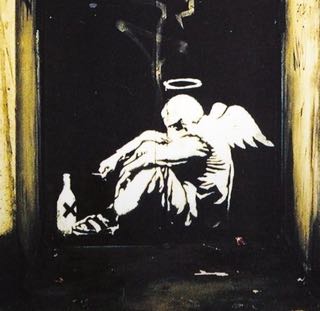By Mary Gustafso
At first, I saw the heartwarming message of redemption and forgiveness contained in this story, but after a year of reflection, I can see the recovery story hidden in this miraculous text.
When Angulimala was born, his astrologer saw weapons flashing in the star constellations and predicted a lifetime of violent crime. Angulimala’s father named him Ahimsaka, which means “harmless one,” in an attempt to prevent this terrible fate. No one could have guessed that Ahimsaka was destined to reach enlightenment in this lifetime, having learned enormous lessons as a man-eating spirit in his previous life.
He was bright and sent off for an education with a well known Brahmin guru. He excelled in his studies and his practice and became known as the “Bright One.” However, bright lights are bothersome to most people and the other students of the Brahmin concocted a scheme to be rid of Ahimsaka. Unable to control their misguided jealousy, they told the teacher Ahimsaka was having an affair with the his wife.
Ahimsaka, reputed to be as strong as seven elephants and as agile as a cat, frightened the guru. Instead of confronting Ahimsaka about the affair, he decided to trick him by issuing a final, fatal lesson. He told his unsuspecting student to gather 1,000 right hand pinkie fingers and bring them back as evidence of his conquest.
At first Ahimsaka objected, but he was soon overcome by his desire to succeed. He regretfully agreed to comply with this terrible request. He killed people for their fingers and hung the gruesome evidence on a garland in a tree. When birds ate the flesh, Ahimsaka decided to fashion a necklace so that he could protect his grotesque prize and finish his evil mission.
He became known as the frightening Angulimala—finger necklace—as he traveled through villages, searching for more victims to complete his awful task.
In the ancient language of Sanskrit, Anguli can be translated as fingers, and Mala refers to a necklace, typically made of wooden beads, used by Buddhists like a rosary in meditation.
The act of killing reawakened the evil, man-eating spirit within him. Angulimala became obsessed with completing his destructive mission. He was unable to stop himself and noticed he was losing his mind. The finger necklace terrified people, of course, and the former “bright one” began to see himself the way others saw him; as a terrifying, evil monster.
With 999 fingers around his neck, he set out to complete his total self-destruction by killing his final victim.
Like all religious tales, there is the element of magic in this story. The Buddha, awakened and walking the earth, knew that Angulimala was not meant to be a killing machine. The wise monk miraculously appeared in front of the crazed student, who was breathlessly running through the forest looking for the last of his 1,000 victims, wearing 999 little, decaying fingers around his neck. The Buddha knew that Angulimala’s mother was searching for her lost son, hoping to stop him from a heart wrenching fate. She is in the same forest as her desperate son, unaware that her child has gone completely insane and will kill his own mother to complete his nefarious objective.
In Buddhist philosophy, matricide is an evil act that causes the perpetrator to be sent on a direct, unavoidable path to the lowest of the deep hells of samsara (existence) in their rebirth. Killing any mother prevents the possibility of nirvana for many lifetimes; killing your own mother is an act that might permanently block enlightenment.
When Angulimala sees the Buddha, he is inspired with the idea to kill him. He starts to chase the Buddha, who does not run, but merely appears to walk along, just out of Angulimala’s reach. No matter how hard the killer runs, he cannot catch up to the Buddha. Finally out of breath, Angulimala is forced to stop, leaning over and panting.
“Monk, stop! You must stop!”
The Buddha turns to him with the hint of a smile.
“Man, I have already stopped. You must stop. When will you stop?”
Like a man hearing the thunderous voice of God, Angulimala falls to his knees and sees the truth of his life. He prostrates himself, begging forgiveness and grace.
In the 12 steps, we are instructed to develop and practice belief in a power greater than ourselves that can and is restoring us to sanity.
I stood in a driveway, staring at my possessions, tossed violently onto a wet garage floor. I was begging for this to stop, when I heard the sure center of my quiet mind whisper to me, “It has stopped. When will you stop?”
I dove back into recovery, so deep that I am forced to wear it like a scuba tank in the black depths of the ocean, unable to breathe without daily practice.
When angry villagers beat Angulimala with sticks and stones, he begs for the Buddha to stop them. The Buddha refuses, telling his new friend to take it as a gift.
“It is better than 10,000 lifetimes for your terrible deeds! Take it! Take it now!”
I had to take the disappointment of my friends, the embarrassing truth about my inability to control my compulsion, and the terrible impact of making amends, which were completely refused and unappreciated. My sponsor assured me this was better than a lifetime of disconnection from my higher self.
Eventually, Angulimala is offered a chance at redemption. He offers help to a pregnant woman who is worried about the health of her fetus. The Buddha tells him to let her know that he is living proof miracles are possible.
This chant is still used by monks today, in blessings for pregnant mothers.
“Sister, since I was born with the noble birth (when he became a monk), I do not recall intentionally killing a living being. Through this truth, may there be well being for you, and well being for your future.”
Initially the Buddha wanted Angulimala to say Since I was born, I do not recall intentionally killing a living being. Angulimala refused, telling the Buddha he could not lie. The Buddha gently changed the language, but still used the word born to help Angulimala, who felt such great remorse for his terrible deeds that he was having difficulty with his meditation practice.
As the pregnant woman miraculously recovered, the villagers softened their stance about the former killer and accepted him as a disciple of the Buddha. Angulimala kept his name, following the Buddha’s instructions to keep it as a reminder of the consequences of losing his mindfulness.
“No matter how far down the scale we have gone, we will see how our experiences can benefit others.”
I connect with people in recovery all over the world, who tell me my story of falling below the bottom of the bottom and finding the immense benefits of a steady faith practice inspired them to save their own life. We identify ourselves by our compulsion, reminding ourselves that we are one breath away from relapse without our practice.
Long before the 12 step philosophy was invented, and Jesus uttered his beautiful words of forgiveness on the cross, the idea of redemption and recovery was learned and passed on to the newest of the new.
We should tell every newborn child this truth.
Be well and live in joy.
Mary Gustafson is a professional author, copywriter and an e-commerce editor who wrote a book called My Wish, The Story of a Man Who Brought Happiness to America. Her essays have been published in literary journals, and she is currently working on Summer, a novel about a girl’s childhood in the 1960s.
Mary describes herself as an author with a long childhood and many life experiences that have morphed into transformative story sources as a result of therapy, practice, and time.
You can find her on Facebook, Twitter and at maryswriting.com.
Photo: (source)
Editor: Alicia Wozniak
Comments
- Zen Buddhism and the Blues - April 5, 2024
- Escaping from Jehovah’s Witnesses through a Buddhist Path - March 24, 2024
- Getting to Know Holly Herring - February 29, 2024





